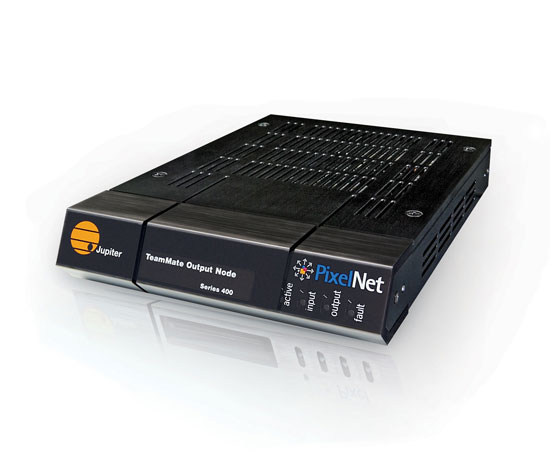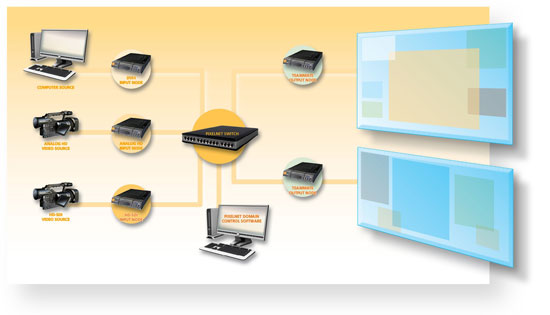![]() Jupiter Systems (www.jupiter.com), the industry leader in display wall processors, announced the launch of its new PixelNet® product line in Europe. The company will be exhibiting PixelNet at the Integrated Systems Europe convention in Booth #2B45 at the Amsterdam RAI Centre on 3–5 February 2009.
Jupiter Systems (www.jupiter.com), the industry leader in display wall processors, announced the launch of its new PixelNet® product line in Europe. The company will be exhibiting PixelNet at the Integrated Systems Europe convention in Booth #2B45 at the Amsterdam RAI Centre on 3–5 February 2009.
PixelNet® distributes the process of capturing inputs, routing signals, and displaying content, among intelligent nodes, making it easier and less expensive to design, build, and manage complex control rooms. This revolutionary new technology can display these varied inputs in a wide range of applications, from very large display walls with multiple inputs and outputs to a single desktop. A significant improvement over current technology, PixelNet can be applied to fulfill requirements ranging from simple meeting room AV systems to complete building AV distribution and display, and everything in between (see attached illustration).

“This is a game-changing product,” said Brady O. Bruce, Jupiter’s Vice President of Marketing and Strategic Alliances. “Using PixelNet nodes, about the size of a paperback book, our users can build a powerful PixelNet visual network quickly and easily. PixelNet is incredibly scalable. To handle an additional input, you just add an input node. To add a new display, you simply connect one more output node. New nodes are automatically detected and integrated by the system. The simplicity is amazing and the video quality is stunning. PixelNet’s high video quality enables Jupiter’s entry into new emerging entertainment applications. There is nothing else like it.”
Breakthrough technology found in data communications networks
Based on technology widely used in data communication networks, PixelNet adopts Gigabit Ethernet and Ethernet switches for use with high resolution, real-time video. Using packet-switching technology any information source can be shown on any display, as a window on a single display, or as a window spanning multiple display devices in a display wall. Any source can be shown at any size on any display or array of displays.

“Plug and play” scalability
Powerful and flexible, PixelNet’s greatest benefit is its scalability. The same component parts can scale from a single input sent to a single output to literally hundreds of inputs and outputs. Outputs can be defined as a single display or logically grouped together to create one or more display walls. If another input is added or the entire wall must be expanded, it can be done by simply adding a few PixelNet nodes. There is no need to reconfigure the entire system.
Hot pluggable and hot swappable
PixelNet input nodes are small, silent and use very little power. Input and output nodes are hot-pluggable and hot swappable, and since PixelNet is based on Ethernet technology, the entire system is inherently fault-tolerant. PixelNet makes creating complex topologies of inputs, outputs and switches simple, cost effective, and future proof.
All of this power and flexibility is managed by Jupiter’s PixelNet Domain Control software, which provides an intuitive, object-oriented, drag-and-drop interface to control and manage multiple inputs, outputs and display walls.
Applications that would traditionally require many separate vendors and a heterogeneous solution can be addressed with a single system of interconnected PixelNet nodes controlled through the PixelNet Domain Control software. Third party applications and control systems are supported with the included API and network control protocol.
PixelNet nodes can also integrate with Jupiter Fusion-based systems via PixelNet FusionLink™.
All digital system
PixelNet is an all digital system. Input and output signals can be either digital or analog, to meet the interface requirements of the attached devices. Inside the PixelNet domain, however, signals are always digital and can be transmitted long distances without degradation. All video processing is done in the digital domain, including cropping, scaling, de-interlacing and noise reduction.
Switching is entirely in the digital domain to preserve signal integrity and to provide pixel-by-pixel routing with built-in up and down-scaling so any rectangle of pixels from any source can be sent to any destination rectangle on any display device.
PixelNet provides implicit format conversion. Signals captured as VGA, DVI, SDI, HD-SDI or HD component can be displayed on any DVI or VGA monitor or projector.